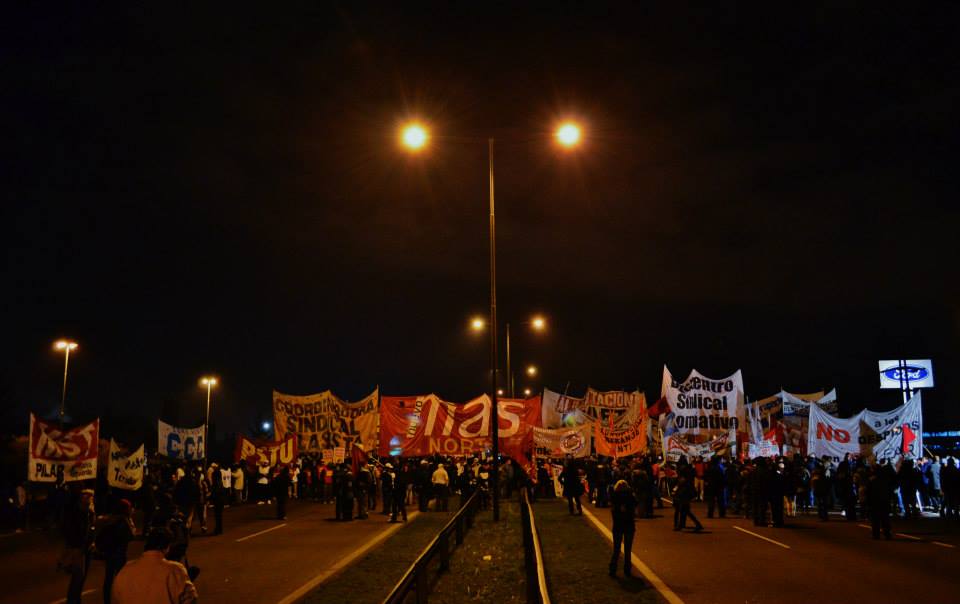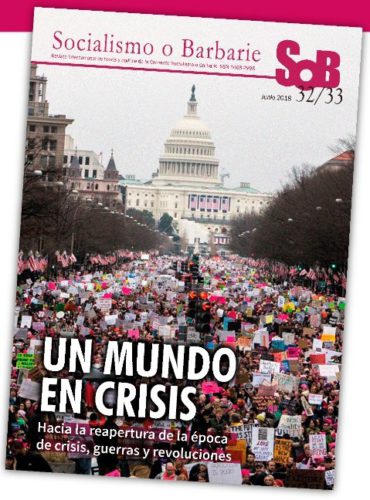
This article was written while we were still participating in the third national strike against Kirchner government. It has been a compelling strike; the majority didn’t show up at work. The bus service worked normally, but they were empty. The decission of the UTA (Union de Tranviarios y Automotores – Tramway and Automotive Union, the bus drivers union) of not joining the strike had no effect. This Thursday looked like a Sunday. The reason behind the strong strike is clear: the workers increasing anger against the economic downturn.
The prices are going off through the roof, and money is losing its value quickly. Layoffs and imposed “short time” [1] have been increasing in the past few weeks. Parallel dollar [2] exchange value has reached its higher number, $14 pesos. The main question is how things will turn out, to which side the circumstances will lean. The government needs to get some “economic fresh air”; if not there could be a new general crisis like the one we lived at the beginning of the year.
Another relevant fact is that the Left (in Argentina, the revolutionary left is referred to as simply “the left”) successfully carried on picket lines around the country. Our party fulfilled a vanguard role at the two most important pickets: Panamericana and Henry Ford, and at Pueyrredón bridge (we participated in more than ten pickets around the country [3]. The roadblocks were less rough than on April 10ª, where the government tried to stop the blocks at the Panamericana highway unsuccessfully.
Wisely, seeing that the conditions were not favorable, they avoided polarization. There was a minor struggle when the protesters were trying to ascent Pueyrredon Bridge, but there was a lack of conviction from the police. In the end the government just wanted to call it a day.
The fact that buses actually worked and people decided not to leave their houses made the effects of the block roads less decisive. Despite that, the media coverage highlighted “Moyano, Barrionuevo, Micheli and the left’s strike” [4] reflecting the left raising role, both in political and union domains, in our country’s political reality.
Moyano’s play
Anyway, it can be said that there were no “excess”: the strike went by under control because Moyano acted carefully in order to stop it from getting out of his control. After many months of waiting he foresaw to call the strike as late as he could do, in order to let the workers cool down. Between the announcement and the realization of the strike there was just one week.
The UTA’s decision to not participate on the strike became an unexpected problem. Fernandez (the UTA leader) argument turned out to be the governments one “it isn’t the moment for a general strike”, with the excuse the “country” is struggling with the “vulture funds”.
Nevertheless the strike was a “great national strike” because the economic situation has deteriorated once again, because the austerity measures weights down on the workers, because there is a growing discontentment with the government from broad social sectors that used to support it ; discontentment which has been growing along the year in spite of a certain recovery of government’s popularity in July; popularity which might have reached a roof once again and begun to retreat.
Giving such a short amount of time for the preparations, however, Moyano tried (and in great measure managed) to make it as inactive as he could. This was done in order to prevent from being pushed to “go further”, to prevent the strike from having the effect –unwanted to him- to break the “numbing” effect of the electoral calendar or destabilizing the more general situation.
From now on we can try out a comparison between this general strike and the previous two. This one can be placed in the middle of 10A and 20N. In comparison to the one in the past April we feel it was less strong, less “hot” than that one since the strike of April took place at the beginning of a brutal austerity plan, when it was not sure that plan could be imposed to the working class; the political atmosphere was a lot tenser than today (although the actual situation could worsen as the economic crisis continues).
As for November 20th 2012, let’s remember that this had the “spicing” of being the first general demonstration against the “Kirchnerist” government. But somehow its turnout had more disparities, although with the condiment that the left picket lines were organized for the first time, modifying in part, more or less “symbolically”, the passive character of the strikes called by the CGT.
This does not mean that today’s strike hasn’t had disparities. It was very strong in the unions which called for the strike, and also in the automotive terminals in the northern area of the great Buenos Aires and Córdoba (most of them gave the workers “the day off” because due to the working organization of the “just in time” method they lose more money working irregularly than they not producing at all), just like the in the Food Union at a national level. However, in the Metalurgy Unionthere were more disparities. Many auto-part factories worked with certain normality. Valeo in Córdoba, which comes from strong fights, worked. Same as Meterfer, where the bureaucracy had just taken measures against lay-offs. In the tire industry, the “Kirchnerist” bureaucracy of Pedro Wasiejko called everyone to work; but in Fate, the immense majority of the workers did not work.
Moyano and Barrionuevo say that once again “they will give the government time to answer”… But they already know that Cristina will not answer a thing. And the government also knows that as for what depends on “moyanism”, things are not going to step up either…
Either way, the general dynamics of the situation will not depend on what Moyano wants. Not even on what the government wants. The rhythm of things will be set by the economy, which at this time looks to be entering a new spiral of chaos.
Micheli bets on the bourgeois parliamentary opposition
On their part, the “mischelism” staked everything on the march of the 27th but were conspicuously absent on the picket lines of the 28th. The CCC –Maoist- and the MST, very weak on the picket lines, went dragging their feet to the march to Congress, to which also went, wrongly from our perspective, the PO. A march that was politically confusing, to say the least.
It’s just that a mobilization made the previous day to a general strike, focused towards Congress and not Plaza de Mayo –place of the Presidential Palace-, and creating-in fact- the illusion that hand in hand with the bourgeois parliamentary opposition we might answers the workers demands (the prohibition for a year of dismissals and imposed short time, the elimination of salary taxes…), can only be defined as an opportunist policy that aims at destroying the political independence of workers. Instead of trusting in their direct action, the solutions would come of some kind of “parliamentary chicanery” from the parliamentary opposition. An example of this is the expectations that Micheli created in his speech about how “the government might be about to lose their parliamentary majority, so the opposition might have the opportunity to vote laws in favor of workers”…
Independently from that, the strike of state workers had had a big impact and contributed in its way to the creation of a general atmosphere of “abnormality” towards the general strike, so many people were inclined not to go to work witnessing the picket lines of the 27th.
The role of the left
It’s on the context we have described that the role of the left on the picket lines must be evaluated.. The first one, and the most strategic, was the one in Henry Ford and Panamericana. The Panamericana highway was blocked at 5.15 am by an agreement between our party and the PO ( afterwards, other currents and vanguard working sectors joined the blockage).
This is already an strategic characteristic of the period. The media announced the strike as carried out by “Moyano, Barrionuevo, Micheli and the left”. Meanwhile, Pignanelli (leader of the SMATA, the Automobile Workers Union) complained in the on line portal of La Nación of “how easy it is to paralyze the country with this government”. It’s evident that the leader of the SMATA has an uncontrollable calling for being a rat: the only answer he can think of for anything is to ask for more repression!
In general, there were no problems to carry out the picket lines. It is unclear why the government tried to delay things in Pueyrredón Bridge; perhaps because they cared about guaranteeing the access to the city. But when the situation began to heat up, when more comrades arrived to Avellaneda, it had to let the bridge be blocked, even failing in the attempt to guarantee one free lane.
Also, the strike arrived in a moment of prominence for the left in worker conflicts, but not because of that exempt of big difficulties. With the defeats of Gestamp and Lear still “hot” it remains to be seen how it affects the scenery of worker fights that escape from the control of the unions’ bureaucracy, carried out by the new working generation. The fight in Donnelley is still open, and massive imposed short time are coming in the tire industry, an union with a huge presence of the left.
Towards a new general devaluation?
Anyway, the fact is that the government didn’t try to polarize the strike. Capitanich, a sort of “Prime Minister” made a Press Conference on Monday to say the strike was founded by the vulture funds, but didn’t convince anyone. Cristina considered that the strike was going to have a great turnout, that the anger about the economic situation is in the rise, because of which the political cost of polarizing against the measure would be higher than the benefits.
It’s just that the government did not reach the strike in its best moment. It seemed to recover some popularity points in July, but everything came crashing down when they couldn’t close a deal with the vultures. It’s impossible to arbitrate social conflicts with empty pockets. Without reserves and without an agreement with the holdouts, with the “parallel dollar” shooting up, what they are doing is to prepare themselves for a new general crisis.
Only two weeks ago the government had tried to regain its capacity to mediate the national questions. It did it relaying on the popularity regained a month before. But this capacity “evaporated” a few hours later. The business men overwhelmed them from the right wing questioning the Supplies Law (the government has already practically gone back on this), and, from the left wing, the call for to the general strike was made, and the tough vanguard conflicts continued.
Still, in spite of the bourgeois opposition not playing at anything, only wanting everything to get back on track for the elections of 2015, and their support to the Kirchnerist austerity measures(that is, acting as a stabilizing factor), the thing is that carrying out a renewed attempt at arbitration requires, as we have said, money. And this is what the government doesn’t have.
The arcs of the Central Bank are empty, they lack funds. And this worsens when, not reaching a deal with the vultures, the dollar has just shot up to 14.38$, the highest value in the whole administration.
A parallel dollar out of control only makes the uncertainty about the future of the country even bigger, putting once again the devaluation of peso at the order of the day just like in January and putting in question the conjuncture as a whole: towards the elections of 2015 or towards a renewed situation of general crisis?
We need a unified national meeting
The left has been unable to answer to the situation. It had slow reflexes to face the austerity measures in the first half of the year. The PO only had its mind in the presidential elections of 2015. The PTS revolved their whole campaign around the liberty of the workers of Las Heras. Neither ordained their politic around facing the Kirchnerist austerity measures, as they should have. The FIT (Workers’ and Left Front, constituted by the PO, the PTS and IS) showed what they really are: “a machine to prevent” from organizing unified campaings. They didn’t provide an answer to the issue of the debt either, or, even less in a unified manner, to the tough ongoing workers conflicts. They never managed to be a real regrouping pole; they are only an electoral cooperative.
At the same time, the conflicts of Gestamp and Lear putt the new worker generation in the center of the scene; while opening a strategic debate around how to face this conjuncture of tough workers struggles, with which strategy we should orient them.
In the last few weeks the fight of Lear was in the center of the scene, being widely covered by the media. But now it’s going through an extremely hard defeat, and what comes next is a campaign for the reinstallation of the fired comrades and for the lives of the former delegates not to be made impossible.
The left arc must stop going in circles, it must stop navel-gazing. After the national strike and before the possibility of scenery of renewed crisis, a Unified National Meeting of rank and file activists and of local unions that were “regained” from the control of the unions’ bureaucracy is more necessary than ever. And the issue is raised, also, once and for all, to open a general re-discussion between the FIT and our party (which is in a straight line towards national legality) about the left fronts’ that leaves behind the dead end of electoralism.
____________________________________________
[1] As a response to the crisis, employers will reduce working days while paying a reduce percentage of salary.
[2] With government controlling the currency market, people who want to buy dollars must go to the black market; thus the term “parallel dollar”.
[3] The PTS was on the rearguard of both blockings, arriving late, our party arrived first to both of them, alongside the PO
[4] Moyano, Barrionuevo and Micheli are three of the biggest union bureaucrats that called the strike.
Socialism or Barbarism Journal N°302, 29/08/2014


